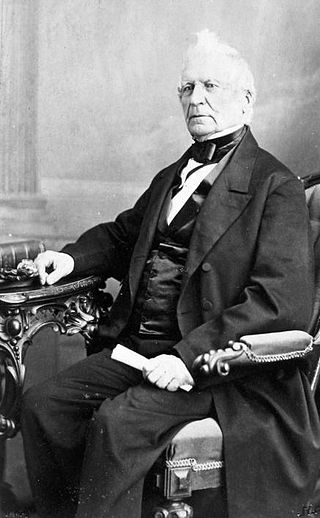
Louis-Joseph Papineau, born in Montreal, Quebec, was a politician, lawyer, and the landlord of the seigneurie de la Petite-Nation. He was the leader of the reformist Patriote movement before the Lower Canada Rebellion of 1837–1838. His father was Joseph Papineau, also a politician in Quebec. Papineau was the eldest of eight children and was the grandfather of the journalist Henri Bourassa, founder of the newspaper Le Devoir.
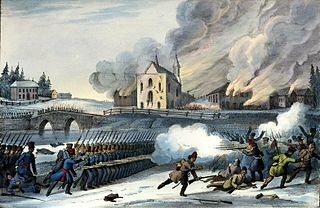
The Lower Canada Rebellion, commonly referred to as the Patriots' War in French, is the name given to the armed conflict in 1837–38 between rebels and the colonial government of Lower Canada. Together with the simultaneous rebellion in the neighbouring colony of Upper Canada, it formed the Rebellions of 1837–38.

Saint-Eustache is an off-island suburb of Montreal, in western Quebec, Canada, west of Montreal on the north shore of the Rivière des Mille Îles. It is located 35 km (22 mi) northwest of Montreal.

Mirabel is a suburb of Montreal, located on the North Shore in southern Quebec.

Pierre-Joseph-Olivier Chauveau was a Canadian lawyer and politician. Chauveau was the first premier of Quebec, following the establishment of Canada in 1867. Appointed to the office in 1867 as the leader of the Conservative Party, he won the provincial elections of 1867 and 1871. He resigned as premier and his seat in the provincial Legislative Assembly in 1873.

This section of the Timeline of Quebec history concerns the events in British North America relating to what is the present day province of Quebec, Canada between the time of the Constitutional Act of 1791 and the Act of Union 1840.
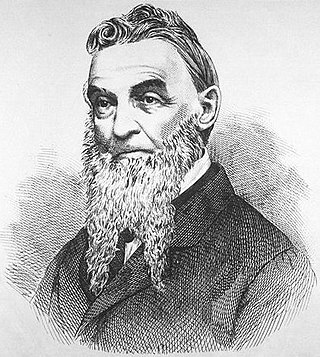
Robert Nelson was an Anglo-Quebecer physician and a leading figure in the Lower Canada Rebellion in 19th century Quebec.

Ludger Duvernay, born in Verchères, Quebec, was a printer by profession and published a number of newspapers including the Gazette des Trois-Rivières, the first newspaper in Lower Canada outside of Quebec City and Montreal, and also La Minerve, which supported the Parti patriote and Louis-Joseph Papineau in the years leading up to the Lower Canada Rebellion.
John Simpson was a government official and political figure in Lower Canada. Elected to the Legislative Assembly of Lower Canada in 1824, he supported Governor General Lord Dalhousie in his disputes with the Assembly over popular control of the provincial government. During the Lower Canada Rebellion he supported the government, but treated the Patriotes with generosity and respect. He recommended amnesty for most of the Patriotes, with exile to Bermuda for the leaders. Simpson served one term in the new Legislative Assembly of the Province of Canada, voting in favour of the union and again generally supporting the Governor General.
Amable Berthelot was a Canadien lawyer, author and political figure. He was elected to the Legislative Assembly of Lower Canada and later to the Legislative Assembly of the Province of Canada. Trained as a lawyer, he was an avid book-collector, at one point having a personal library of some fifteen hundred volumes. He did not support those who took up arms during the Lower Canada Rebellion of 1837–1838. He never married, but adopted two children, a boy and a girl. His daughter married Louis-Hippolyte LaFontaine, later co-premier of the Province of Canada. He was a literary mentor to François-Xavier Garneau.
Jean-Moïse Raymond was a businessman, militia officer and political figure in Lower Canada, and briefly in Canada East, in the Province of Canada. He was active in a family business inherited from his father, and also served in the Lower Canada militia during the War of 1812, at the Battle of the Châteauguay. As a member of the Legislative Assembly of Lower Canada, he was critical of British government of the province, voting in favour of the Ninety-Two Resolutions, which set out a detailed list of problems with the government. He opposed the union of Lower Canada with Upper Canada. Following the union of those two provinces into the Province of Canada, he was elected to the Legislative Assembly of the new province, but resigned his seat after only one year to take a government appointment. He died in 1843.
Louis-Michel Viger was a lawyer, businessman, seigneur and political figure in Lower Canada and then in Canada East in the Province of Canada.
William Henry Scott was a businessman and political figure in Lower Canada and Canada East.
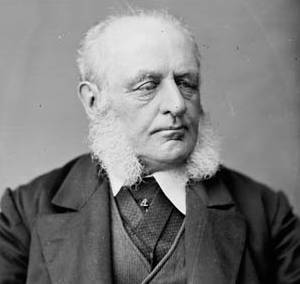
Léandre Dumouchel was a Quebec doctor and political figure. He was a Conservative Party of Canada member of the Senate of Canada for Mille Isles division from 1867 to 1882.
Joseph-Narcisse Cardinal was a notary and political figure in Lower Canada. He was the first person executed for taking part in the Lower Canada Rebellion.
Jacques Labrie was a physician and political figure in Lower Canada.

Joseph Girouard was a Quebec notary and political figure. He represented Two Mountains in the House of Commons of Canada as a Conservative member from 1892 to 1896.
The following is an incomplete bibliography of the 1837-1838 insurrections in Lower Canada in the English and French languages, by publication date and document type.

Jean-Baptiste Dumouchelle was born in Sandwich, Upper Canada. He was a leading figure in Saint-Benoît through his pursuits as a militia officer, general merchant and magistrate.
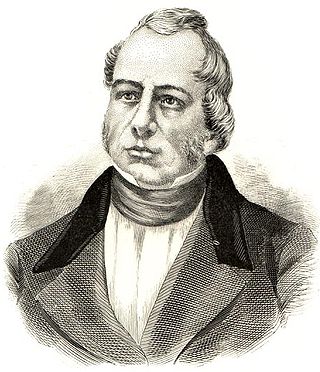
Joseph Masson was a Canadian businessman, who is considered the first French Canadian millionaire.












